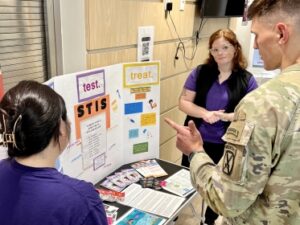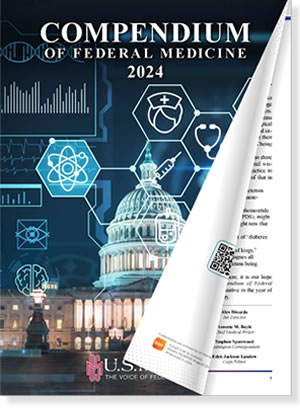
Last year, nursing students from Northwestern State University of Louisiana conducted a service-learning project about the prevention and treatment of sexually transmitted diseases for servicemembers at the Joint Readiness Training Center and Fort Polk, LA. In this photo, from left, Jennifer Joo, 1st Lt. Nick Bonicoro and Laura Brigman discuss prevention and training opportunities for the 2nd Battalion, 4th Infantry Regiment, 3rd Brigade Combat Team, 10th Mountain Division at the Soldier Centered Medical Home. Photo by Jean Graves, Fort Polk, LA
BETHESDA, MD — Sexually transmitted infections (STIs) affect an estimated 1 in 5 servicemembers, making early diagnosis and treatment important for controlling their spread among this high-risk population.
Point of care tests (POCT), which offer quick results and sensitivity and specificity that is reported to be on par with laboratory tests, have had variable use in the civilian population. Their use among military providers, however, had not been evaluated, said Jill Brown, MD, MPH, MHS, director of women’s health clinical outcomes and diversity at Uniformed Services University of Health Science, and lead author of a new study identifying the patterns of use and barriers to using STI POCTs for the military.
Brown and her colleagues conducted the study with responses to an online survey, which they adapted from one used with civilian OBGYNs and sent to 479 military OBGYNs via Army, Air Force and Navy specialty leaders in May 2023. The questionnaire included 14 demographic questions and up to 52 questions regarding availability, use and barriers to STI POCTs.1
Of the 117 OBGYNs who completed the survey, 13% reported detecting STIs twice-weekly, and 52.8% reported detecting them once or twice monthly, the researchers reported in Military Medicine. The most available STI-related POCTs were wet mount prep or vaginal smear (68.7%); rapid HIV (43.3%); and urine dipstick (38.6%). Gram stain was available for 30.3%; the Affirm VPIII, which uses DNA probe technology to identify Candida species Gardnerella vaginalis and Trichomonas vaginalis was available for 24.5%; and stat RPR, a rapid blood test for syphilis, was available for 16.3%.
Economic barriers to using POCTs included cost of the test from manufacturer/distributor (57.9%) and military funding/stocking decisions (10.3%), they reported. The greatest barriers to use were the purchasing of an instrument (60.8%) and the interruption to workflow in clinic (57.8%).
“Not too surprising, some of our findings were different from what was seen in the civilian survey,” Brown told U.S. Medicine. “[This] was somewhat expected, because of the payment structure being different in the military. But it did sort of verify that comes into play in the decision-making.”
In the civilian survey, economic barriers included reimbursement for performing the test and payment coverage for the patient, Brown said. In contrast, economic barriers to using POCT in the military study included the cost of the test from manufacturer/distributor (57.9%) and military funding/stocking decisions (10.3%). The greatest barriers to use were the purchasing of an instrument (60.8%) and the interruption to workflow in clinic (57.8%).
The main benefit of POCT is the speed of getting a result, Brown said. “The point of care test idea is to have a result within a couple of hours so that a patient can be treated that same day or ideally within that same encounter,” she continued. “So it potentially would decrease the time to treatment and also down the road decrease the likelihood of transmission, because you have less opportunity for transmission if you are treated sooner.”
Brown said the main implication of the study’s findings is that “when were are thinking about tests that can be used within in the military health system, we need to think about how it is going to impact work flow and also the test cost of the test itself and the different devices or equipment that’s necessary and how that is going to be incorporated in the decision-making from the military clinic standpoint.”
She said she hopes the study will bring attention to the importance of having point care tests in the military. “We certainly have a population that’s at risk, so hopefully bringing the attention to the need for point-of-care tests will potentially encourage people who have a role in the decision-making to invest in these methods.”
“As military providers, we have an opportunity to inform people who are making decisions about stocking the way that the different tests are provided and how it can benefit the patients in using one methodology over another—particularly with the point-of-care tests,” she said.
- Brown, J. E., Hudson, K. M., Rompalo, A. M., & Gaydos, C. A. (2024). Patterns of Use and Barriers to STI Point-of-care Tests for Military Obstetrician Gynecologists. Military Medicine, usae283. Advance online publication. https://doi.org/10.1093/milmed/usae283

